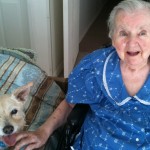 Ten-year-old Anicee Lamoreaux has already had 100 broken bones due to osteogenesis imperfecta, or brittle bone disease, but that’s not stifling her excitement over her new service dog, Pearl. Pearl hasn’t completed her training yet, but once she does, she’ll be the newest Lamoreaux family member, responsible for helping Anicee perform daily tasks. But more importantly, Pearl will be the friend Anicee needs. Anicee’s parents, both of whom also have osteogenesis imperfecta, are raising money to help cover the $10,000 cost for Pearl and her training. Daily Camera (Boulder, Colo.)
Ten-year-old Anicee Lamoreaux has already had 100 broken bones due to osteogenesis imperfecta, or brittle bone disease, but that’s not stifling her excitement over her new service dog, Pearl. Pearl hasn’t completed her training yet, but once she does, she’ll be the newest Lamoreaux family member, responsible for helping Anicee perform daily tasks. But more importantly, Pearl will be the friend Anicee needs. Anicee’s parents, both of whom also have osteogenesis imperfecta, are raising money to help cover the $10,000 cost for Pearl and her training. Daily Camera (Boulder, Colo.)
They’ve only known each other a few short weeks, but Anicee and Pearl are already partners in crime.
Pearl, a 14-week-old labradoodle, has a fluffy puppy-dog face anyone would love. But she is loved most of all by her 10-year-old owner, Anicee Lamoreaux, who is raising money to keep Pearl as her personal service dog.
Anicee, a fifth-grader at Birch Elementary, has osteogenesis imperfecta, also known as brittle bone disease. The condition means Anicee can break a bone simply by coughing or sneezing too hard.
Anicee uses a specialized wheelchair to get around, and Pearl will be a valuable partner who can help her open doors, help with errands and bring her medication or other essential items.
Most of all, Pearl also will be Anicee’s constant companion.
“I’ll have a buddy to spend time with,” she said, feeding treats to her pet in her living room Thursday. “I don’t have that many friends, so I’ll have a friend who will be with me every day, hour, minute.”
Anicee was adopted from Belize in 2010 by her parents, Chris Lamoreaux and Lisa Ferrerio. Both parents also have osteogenesis imperfecta and said they wanted to adopt a child who had a similar condition.
“We knew how much we could offer her,” Ferrerio said. “We know exactly what it’s like to go through surgery or be talked about in school.”
Anicee’s parents also wanted her to have extra help, but the cost of service animals can be overwhelming, especially on top of other medical bills.
The family and their friends are organizing several fundraisers to help cover the estimated $10,000 annual cost to provide Pearl’s specialized training.
As a service dog, she must undergo many hours of training that will familiarize her with Anicee’s specialized care.
That’s worth it for Ferrerio, who remembers the companionship and warmth of her own service dog, Kosmo. Ferrerio had Kosmo when she was a teenager.
When Ferrerio’s longtime friend, dog trainer Ana Melara, came across Pearl, she knew the puppy would be a good fit for the family because of her low-key, gentle temperament. Melara is in charge of much of Pearl’s service dog training.
“She’s just such a sweet dog,” she said.
When Anicee met her dog for the first time, she said she couldn’t contain her excitement.
“I was jumping up and down. I could have broken the wall,” she said with a smile. “I wish I could take her for the whole day.”
Pearl isn’t a permanent resident at Anicee’s house yet, though. Melara is in charge of training the puppy in all the basics, and it could take up to two years before Anicee and her dog become permanent companions. Right now, Anicee and Pearl hang out about twice a week.
Help Anicee and PearlBirch Elementary School student Anicee Lamoreaux is raising money to train her service dog, Pearl.
An art silent auction, featuring art by Anicee, will be from 5 to 8 p.m. Oct. 26 at Pearl’s training center, Training with Grace, 9100 W. Sixth Ave. in Lakewood. For more information, go to facebook.comand search “Anicee and Pearl” for updates and other fundraising opportunities.
To learn more about Anicee’s fundraisers or to donate money to help train Pearl, visithttps://aniceefunds.com.
Ferrerio said the training will help make sure Pearl is the right dog for her daughter, who has experienced about 100 broken bones in her short 10 years. Anicee also has undergone three major surgeries to help strengthen her spine and legs, and she hopes to have Pearl nearby when she undergoes another surgery on her arms sometime next year.
“Pearl will be so important in Anicee’s life,” Ferrerio said. “We’ll need her to be Anicee’s arms and legs, and we need to know that Pearl won’t bolt when she sees something like a squirrel or duck — that would break Anicee’s arm.”
So far, Anicee and Pearl are already fast friends. Anicee can’t wait to introduce her dog to her fifth-grade class and take her dog on the playground.
Her dad said he’s happy Anicee is getting the opportunity. In Belize, she didn’t have the same medical opportunities or the chance to have a service dog.
“Here, she has the medical accessibility she needs,” he said.
Anicee’s grandmother, Diane Holstein, said Pearl will bridge the gap between her granddaughter and her peers. Right now, kids don’t always know how to interact with Anicee, but Pearl’s presence will give them a way to talk and ask questions, she said.
“People will see Anicee at King Soopers, the library, out in the community, and Pearl will help people get to know her,” she said










